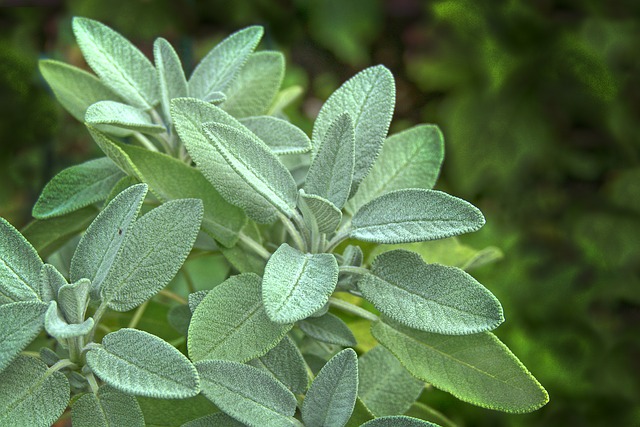Sage has a long history of medicinal and culinary use. With its shimmering silvery-green leaves and pretty blue flowers, the sage plant is as beautiful as it is functional.
Reasons why to grow sage in your garden
1. Very easy to grow
This perennial, evergreen shrub is easy to plant and even easier to care for. It does best in full sun and well-draining soil. If you do companion planting, place sage next to the brassica family, which includes broccoli, cabbage and cauliflower.
Be sure to choose an edible variety of sage to grow in your herb garden, such as Garden Sage, Purple Sage, Tri-color Sage or Golden Sage.
2. It smells beautiful
Plant a truly aromatic garden by adding the distinctive earthy tones of the sage plant to the mix.
3. It repels pests
Planting sage outdoors works well to keep vegetable-loving pests like cabbage moths and carrot flies at bay. Organic gardeners will love it.
4. It attracts pollinators
Bring butterflies, hummingbirds and bees to your backyard with the earthy tones of the sage plant. These creatures will add color and vibrancy to your garden, while helping to pollinate your flowers and plants.
Uses for sage in the kitchen
Sage is a fantastic culinary herb to have on hand. Use it sparingly in the kitchen and in small amounts – it’s enough.
1.Herbal butter
Improve the taste of your butter by adding some homegrown sage. It’s great on top of grilled chicken or fish or tossed with steamed vegetables. This sage butter recipe uses shallots, lemon and black pepper for added kick.
2. Rosemary sage seasoning salt
This flavor combination not only helps preserve your herb garden bounty, it makes for a simple yet delicious meat rub. It can also be stirred into soups and stews, or sprinkled on roasted vegetables and scrambled eggs.
3. Salads
While sage isn’t a traditional salad herb like basil or cilantro are, it can work when paired with the right ingredients. Try this roasted new potato salad with sage leaves; a roasted asparagus and fried sage salad; or a refreshing and detoxing green herb salad.
4. Breads and pastas
Plain home-baked breads and pasta can be easily flavored with a drizzle of sage infused oil, or a smear of sage butter. Sage can also be mixed into the dough of these delicious staples for an herb flavor explosion.
5. Desserts
All manner of herbs can lend a fragrant earthiness to sweet treats – and sage is no exception.
Enjoy it in a grown-up Meyer lemon, sage and olive oil cake; a sweet and crunchy maple sage ice cream with sugared walnuts; a fruity dessert of roasted figs with sage and red wine; or an ingenious brown butter and sage apple pie.
6. Sauces and soups
Sage works in all manner of soups and sauces. When combined with Italian parsley, it makes a powerful pesto. Sage adds a lot to the classic tomato sauce and is perfect in a Tuscan-inspired creamy sage sauce which can be drizzled over vegetables and pastas.
When it comes to soup, sage works best with Fall vegetables – as in this butternut squash and sage soup; this chestnut and sage soup; or an English onion soup with sage and cheddar.
See also: 21 Plants & Herbs you can propagate from cuttings
Health and well-being
Used for ailments ranging from mental disorders to gastrointestinal discomfort, today sage plant is still believed to improve health and well-being in a variety of ways.
1.Sage tea for mouth and throat problems
Sage is commonly brewed into a tea, or used as a gargle, to kill the pain of sore throats, mouth ulcers, gum disease, laryngitis and coughs thanks to its astringent, antiseptic, and antibacterial qualities.
If you have a toothache, mix a tablespoon of sea salt with two tablespoons of dried sage in a little whiskey or water. Swish this around your mouth for a few minutes before spitting out.
2. Improved memory and attention span
Several studies have shown the ability of sage extract or sage essential oils to improve memory, attention span, alertness and mood. Even those with Alzheimer’s disease have been shown to enjoy improved cognitive function and behavior after four months of treatment with sage tincture.
Add sage oil to your diffuser, or inhale the scent of a soothing cup of sage tea for greater alertness and cognition.
3. Natural body deodorizer
For improved health and the good of the environment, embrace natural ways of smelling good – including by eating more sage! Herbs like sage, basil, parsley, mint, and rosemary are all said to be natural body deodorizers when eaten or juiced regularly.
4. Darken grey hair
Make your very own vinegar rinse to hide pesky gray hairs without the use of harsh dyes. Learn how to make the rinse here, and then use it after shampooing several times a week to darken grays over time, add shine, and even deepen your natural brown or black coloring.
Sage oil can also be rubbed into the scalp to address fungal dandruff and reduce oily hair.
5. For your skin
Use sage oil topically to slow down the signs of aging, to prevent scars and bacterial growth, and as a natural moisturizing lotion.
6. Digestive function
A cup of sage tea after meals can help relieve digestive problems like gas or bloating. A spoonful of sage infused olive oil can help relieve constipation.
7. Natural household cleaner
Thanks to its antimicrobial and antifungal effects, sage makes an effective and all-natural kitchen and bathroom cleaning agent – especially when coupled with white vinegar. Research has even shown sage to be effective against both E. coli and salmonella.
Source: www.naturallivingideas.com

